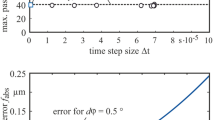Abstract
The dynamic disturbances of the deep-hole drilling process pose a great challenge. Especially spiralling, which causes holes with several lobes, can damage the workpiece irreparably. The causes for spiralling are not well explored yet, and it is important to analyze which conditions and process parameters can cause the spiralling. This article presents a simulation system for the idealized BTA (Boring and Trepanning Association) deep-hole drilling process. Methods of computer graphics allow the realistic modeling of the cutting edge and the workpiece. The simulation is able to calculate the sweep volume, cutting forces, and regenerative tool vibrations. It is also possible to generate the resulting geometry of the workpiece depending on the eigenfrequencies of the boring bar and on the process parameters. Thus, the pre-conditions for the spiralling can be analyzed.
















Similar content being viewed by others
References
VDI-Richtlinie 3210 (1974) Tiefbohrverfahren/Deep-hole drilling. Beuth Verlag GmbH, Berlin
Weinert K, Webber O, Peters C (2005) On the influence of drilling depth dependent modal damping on chatter vibration in BTA deep hole drilling. CIRP Ann Manuf Technol 54(1):363–366
Gessesse YB, Latinovic VN, Osman MOM (1994) On the problem of spiralling in BTA deep-hole machining. Transaction of the ASME, J Eng Ind 116:161–165
Weinert K, Weihs C, Webber O, Raabe N (2007) Varying bending eigenfrequencies in BTA deep hole drilling: mechanical modeling using statistical parameter estimation. Prod Eng Res Dev 1(2):127–134
Biermann D, Weinert K, Enk D, Hossam M, Raabe N (2008) Controlling approach for the BTA deep hole drilling process to avoid spiralling. In: The 1st international conference on process machine interactions. Editor Berend Denkena, Hannover, pp 53–60
Altintas Y, Brecher C, Weck M, Witt S (2005) Virtual machine tool. CIRP Ann Manuf Technol 54(2):115–138
Surmann T, Biermann D, Kehl G (2008) Oscillator model of machine tools for the simulation of self excited vibrations in machining processes. In: The 1st international conference on process machine interactions. Editor Berend Denkena, Hannover, pp 23–29
Tobias SA (1961) Schwingungen an Werkzeugmaschinen. Carl Hanser Verlag, Muenchen
Foley JD, van Dam A, Feiner SK, Hughes JF (1992) Computer graphics: principles and practice. Addison-Wesley, Reading
Huang Y, Oliver JH (1994) NC milling error assessment and tool path correction. In: Proceedings of the 21st annual conference on computer graphics and interactive techniques, pp 287–294
Kienzle O, Victor H (1952) Die Bestimmung von Kraeften und Leistungen an spanenden Werkzeugen und Werkzeugmaschinen. VDI-Z 94(11–12): 299–305
He J, Fu Z-F (2001) Modal analysis. Butterworth Heinemann Verlag: Oxford
Brigham EO (1988) The fast Fourier transform and its applications. Prentice Hall, Upper Saddle River
Acknowledgments
This work has been supported by the Collaborative Research Center “Reduction of Complexity in Multivariate Data Structures” (SFB 475) of the German Research Foundation (DFG).
Author information
Authors and Affiliations
Corresponding author
Rights and permissions
About this article
Cite this article
Biermann, D., Sacharow, A. & Wohlgemuth, K. Simulation of the BTA deep-hole drilling process. Prod. Eng. Res. Devel. 3, 339 (2009). https://doi.org/10.1007/s11740-009-0176-y
Received:
Accepted:
Published:
DOI: https://doi.org/10.1007/s11740-009-0176-y




